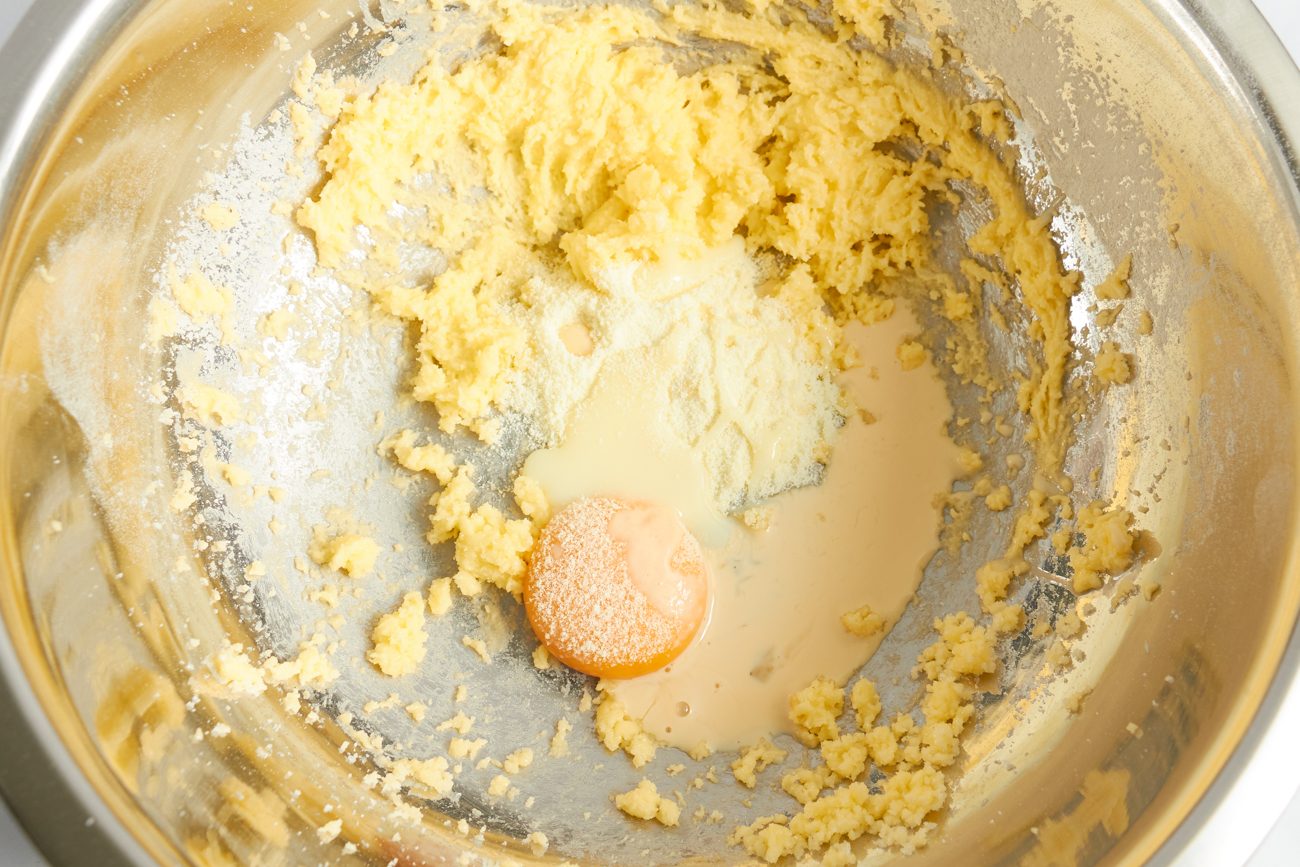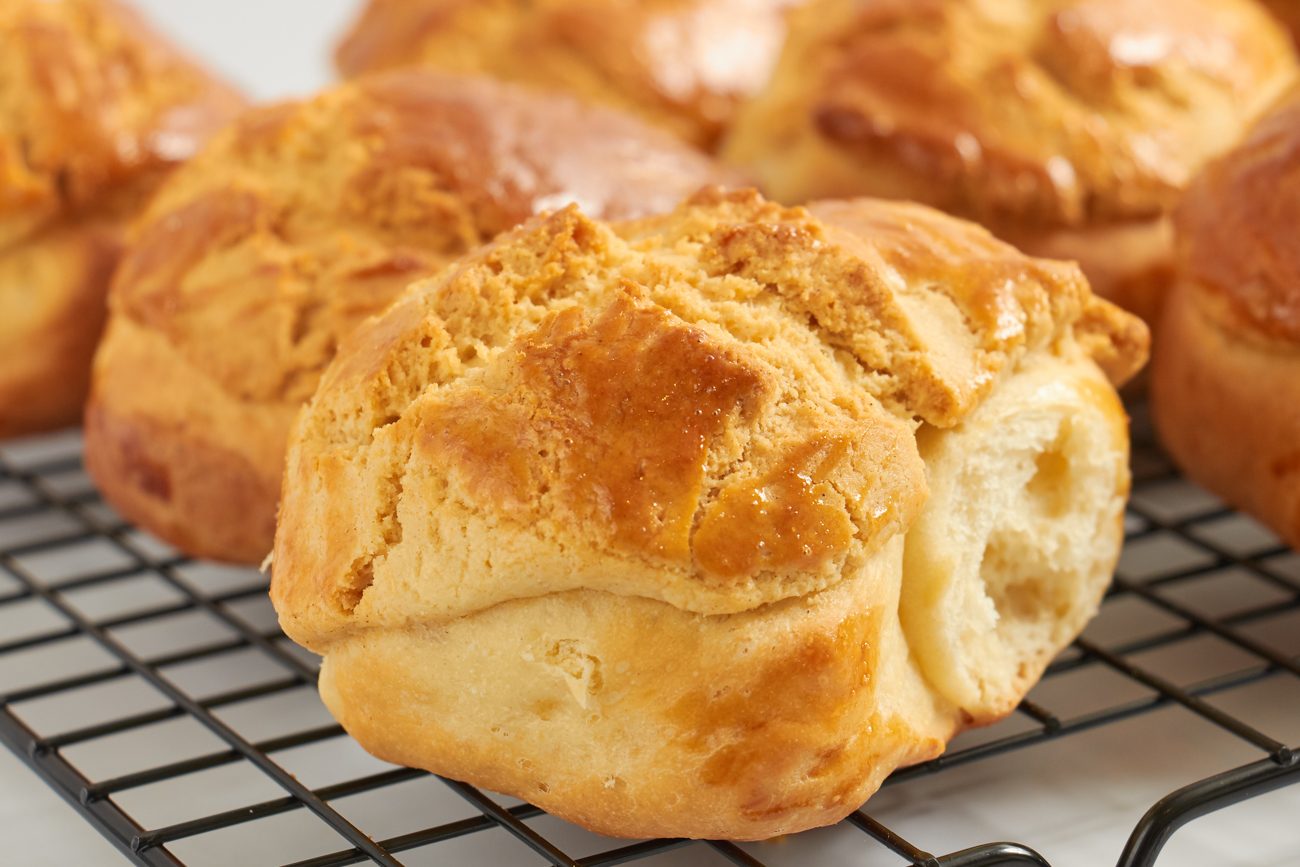Pineapple Buns: the Chinese recipe for sweet bread buns
;Resize,width=742;)
Ingredients
These sweet bread buns are a classic in Hong Kong, and there is a bakery shop there which specializes in making and selling pineapple buns, which are called Bo Luo Bao.
You may be surprised to find out that there is no actual pineapple in these buns – the name refers to the crackled topping that looks a bit like pineapple skin.
They take a bit of time and patience to make, as the dough has to go through two provings, and the topping has to be made separately, but the hassle is worth it, for these buns are so light and fluffy with a hint of sweetness, and a sweet crunchy topping.
These buns are delicious as-is, or try cutting in half and spreading some butter on. Divine!
Instructions
Combine all dry ingredients: flour, salt, sugar and yeast in a bowl. Make a well in the center.
Whisk and combine all wet ingredients: milk, egg and tangzhong*, then add into the well of the dry ingredients.
When all ingredients are mixed together, knead in the softened butter.
The dough is quite sticky and messy at this stage, so you can add a little more flour if you’re kneading by hand. Keep kneading until the dough is smooth, not sticky and elastic.
Shape dough into a ball. Place in a greased bowl and cover with a wet towel or cling wrap. Let it proof till it's doubled in size, about 40 minutes.
Transfer the dough to a clean floured surface. Knock out the air, and divide into 12 equal portions. Cover with cling wrap, and let rest for 15 minutes.
While the dough is resting again, make the topping.
To make the topping
Cream the softened butter with an electric mixer over medium speed until smooth. Add sugar and continue to beat until fluffy.
Add milk powder, egg yolk, evaporated milk, condensed milk, baking powder, and combine well. Sift in flour and ammonia powder (if using) and incorporate well.
The mixture is quite moist and sticky, so use a piece of film wrap to roll into a log. Chill for 30 to 40 minutes. When it becomes firm, it’s ready to use.
To make the buns
Knead each little dough portions into ball shapes.
Let them complete the 2nd round of proofing, about 35 minutes until they’re doubled in size.
Preheat oven to 210°C/190C fan/410°F/gas mark 7.
When the dough portions are doubled in size, remove topping paste from fridge, cut into 12 equal portions and roll in balls.
Cover by a film wrap and press each portion into a flat disc.
Place on top of the dough buns, and press down gently. Repeat this step with the rest. Don’t worry if the topping cracks when you do this – this helps to give the buns their crackly look.
Brush the top with whisked egg yolk and bake in a preheated oven for 5 minutes.
Reduce the temperature to 180°C/160C fan/350F/gas mark 4, and bake for another 15 minutes. To check if they’re done, cooked buns will sound hollow if you tap them underneath with your finger.
Notes:
*How to make tangzhong
50g (1/3 cup) bread flour
250ml (1 cup) milk or water. You can even use half milk and half water.
Mix flour in water well, so there aren’t any lumps. Put in a pan, and cook over medium-low heat, stirring consistently with a wooden spoon, whisk or spatula to prevent burning and sticking while you cook.
The mixture will become thicker and thicker quite quickly. Once you notice some “lines” appear in the mixture for every stir you make with the spoon or whisk, it’s done. It only takes a few minutes, and you have tangzhong. Remove from heat.
Transfer into a clean bowl. Cover with cling wrap, making sure it sticks onto the surface of the tangzhong to prevent it from drying up. Let cool.
The tangzhong can be used straight away once it cools down to room temperature. Just measure out the amount you need.
The leftover tangzhong can be stored in fridge up to a few days as long as it doesn't turn grey. (Note: The chilled tangzhong needs to return to room temperature before adding into other ingredients.)
* Ammonia powder is a traditional ingredient for pineapple buns, and can be bought at Asian ingredient stores, but you don’t need to use it – I didn’t use it for these buns. If you use too much, your buns will smell a bit funky!
For the amount of ammonia powder, don’t go over 1/4 teaspoon of it when using 125 grams of cake flour to make the topping. If you use less or more flour, please adjust the amount of ammonia powder accordingly.
;Resize,width=767;)











;Resize,width=712;)
